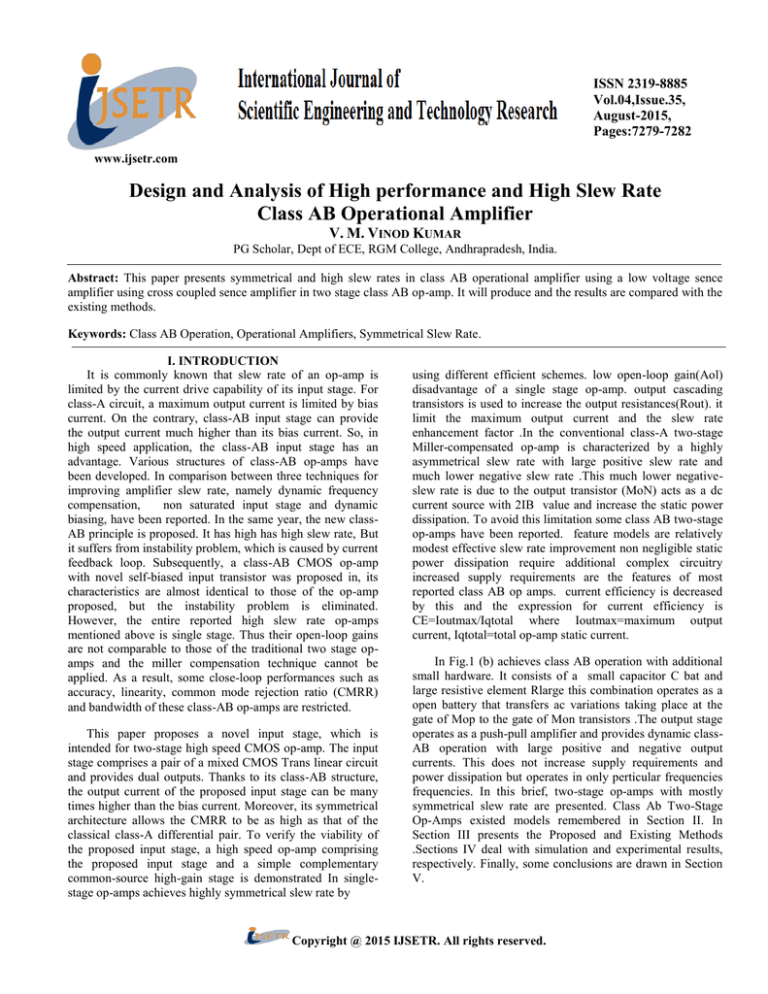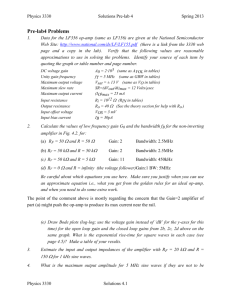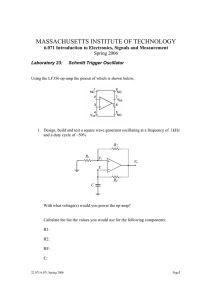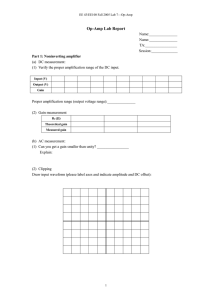
ISSN 2319-8885
Vol.04,Issue.35,
August-2015,
Pages:7279-7282
www.ijsetr.com
Design and Analysis of High performance and High Slew Rate
Class AB Operational Amplifier
V. M. VINOD KUMAR
PG Scholar, Dept of ECE, RGM College, Andhrapradesh, India.
Abstract: This paper presents symmetrical and high slew rates in class AB operational amplifier using a low voltage sence
amplifier using cross coupled sence amplifier in two stage class AB op-amp. It will produce and the results are compared with the
existing methods.
Keywords: Class AB Operation, Operational Amplifiers, Symmetrical Slew Rate.
I. INTRODUCTION
It is commonly known that slew rate of an op-amp is
limited by the current drive capability of its input stage. For
class-A circuit, a maximum output current is limited by bias
current. On the contrary, class-AB input stage can provide
the output current much higher than its bias current. So, in
high speed application, the class-AB input stage has an
advantage. Various structures of class-AB op-amps have
been developed. In comparison between three techniques for
improving amplifier slew rate, namely dynamic frequency
compensation,
non saturated input stage and dynamic
biasing, have been reported. In the same year, the new classAB principle is proposed. It has high has high slew rate, But
it suffers from instability problem, which is caused by current
feedback loop. Subsequently, a class-AB CMOS op-amp
with novel self-biased input transistor was proposed in, its
characteristics are almost identical to those of the op-amp
proposed, but the instability problem is eliminated.
However, the entire reported high slew rate op-amps
mentioned above is single stage. Thus their open-loop gains
are not comparable to those of the traditional two stage opamps and the miller compensation technique cannot be
applied. As a result, some close-loop performances such as
accuracy, linearity, common mode rejection ratio (CMRR)
and bandwidth of these class-AB op-amps are restricted.
This paper proposes a novel input stage, which is
intended for two-stage high speed CMOS op-amp. The input
stage comprises a pair of a mixed CMOS Trans linear circuit
and provides dual outputs. Thanks to its class-AB structure,
the output current of the proposed input stage can be many
times higher than the bias current. Moreover, its symmetrical
architecture allows the CMRR to be as high as that of the
classical class-A differential pair. To verify the viability of
the proposed input stage, a high speed op-amp comprising
the proposed input stage and a simple complementary
common-source high-gain stage is demonstrated In singlestage op-amps achieves highly symmetrical slew rate by
using different efficient schemes. low open-loop gain(Aol)
disadvantage of a single stage op-amp. output cascading
transistors is used to increase the output resistances(Rout). it
limit the maximum output current and the slew rate
enhancement factor .In the conventional class-A two-stage
Miller-compensated op-amp is characterized by a highly
asymmetrical slew rate with large positive slew rate and
much lower negative slew rate .This much lower negativeslew rate is due to the output transistor (MoN) acts as a dc
current source with 2IB value and increase the static power
dissipation. To avoid this limitation some class AB two-stage
op-amps have been reported. feature models are relatively
modest effective slew rate improvement non negligible static
power dissipation require additional complex circuitry
increased supply requirements are the features of most
reported class AB op amps. current efficiency is decreased
by this and the expression for current efficiency is
CE=Ioutmax/Iqtotal where Ioutmax=maximum output
current, Iqtotal=total op-amp static current.
In Fig.1 (b) achieves class AB operation with additional
small hardware. It consists of a small capacitor C bat and
large resistive element Rlarge this combination operates as a
open battery that transfers ac variations taking place at the
gate of Mop to the gate of Mon transistors .The output stage
operates as a push-pull amplifier and provides dynamic classAB operation with large positive and negative output
currents. This does not increase supply requirements and
power dissipation but operates in only perticular frequencies
frequencies. In this brief, two-stage op-amps with mostly
symmetrical slew rate are presented. Class Ab Two-Stage
Op-Amps existed models remembered in Section II. In
Section III presents the Proposed and Existing Methods
.Sections IV deal with simulation and experimental results,
respectively. Finally, some conclusions are drawn in Section
V.
Copyright @ 2015 IJSETR. All rights reserved.
V. M. VINOD KUMAR
Vb triode=Vss+Vgs+VDSsat=VTH+2VDSsat is required at the
II. PREVIOUS CLASS AB TWO-STAGE OP-AMPS
gate of MoNR. Where VDSsat= Vgs-Vth is the minimum Vds
A. Op-Amp with Current Replication Branch
To achieve class AB operation, the output transistor MoN
voltage to operate in saturation region. This Vbtroide leaves a
can be turn into an active amplifying device by simply
quiescent drain-source voltage for MoNtriode with value
adding a current replicating branch formed by M2R and
VDSsat, which causes MoNtriode to operate between triode
MoNR as shown in Fig.1(c).This transfers current variations
and saturation regions boundaries. The circuit of Fig. 2 is
Ia in M1-M2 to the output transistor MoN and increases and
denoted as operational amplifier with current replicating
increases the maximum positive output current by 2IB. The
branch and adaptive loads. These topologies are not harmful
negative current is limited to 2IB.gain in the current
in terms of stability of the ac responses. The current
replicating branch is from gate to the drain of MoN The
replicating branch helps compensating the current through
current replicating branch does not require additional
the miller capacitor just as in other multipath miller zerocompensation circuit. the node Vx that become advantage by
cancellation scheme.
this additional compensation is not required for the current
III. SYMMETRICAL AND HIGH SLEW RATE CROSS
replicating branch and miller compensation causes MoP to
COUPLED TYPE TWO STAGE OP-AMPS
behave as low impedance diode connected load at high
frequency.. The gain between the op-amps output terminal
and the gate of MoN reduced to closely a unity value. The
current replicating branch has small dimensions reducing
static power dissipation and area . For achieve large negative
output currents, non-linear adoptive load can be used similar
to the teqnique introduced.
Fig.2. symmetrical and high slew rate cross coupled type
two stage op-amps.
Fig.1. (a) Conventional two-stage Miller op-amp. (b)
Free-class AB op-amp. (c) Push pull op-amp with current
replication branch M2R, MoNR. (d) Class AB two-stage
op-amp with current replicating branch using adaptive
load II at the input stage. (e) Class AB two-stage op-amp
with current replicating branch using adaptive load I at
the input stage.
B. Class AB Two-Stage Op-Amp Using Adaptive Loads
By using an adaptive load at the input side in the circuit
we can achieve class AB operation efficiently. Two different
alternatives are shown in Fig.1 (d) and Fig.1 (e).In both
cases, the adoptive loads man oeuvre the large variation of
output resistance of transistors between triode and saturation
regions in quiescent conditions. In both schemes a current
increase in IA causes transistors to go in triode region and to
develop large drain-source voltages. These changes cause
large currents flow in the output transistors Mop and thanks
to the current replicating branch, A bias voltage with value
Sense amplifier which detects the voltage difference
on the bit lines is called voltage mode sense amplifier.
There are some different types voltage mode sense amplifiers
like single ended sense amplifiers, differential amplifiers
and Cross coupled sense amplifiers. Different types of
sense amplifier are used in different types of memory
cells
according to the proper design and efficient
performance. Cross coupled voltage mode SA. M1 and M2
are the access transistors, whereas M3-M6 forms crosscoupled inverters. When SAEN is low, M1 and M2 are turned
ON and voltage on BL and BLB will be transferred to SL
and SLB respectively. Due to positive feedback, higher
voltage level goes to VDD and other level goes towards zero.
the nodes SL and SLB are input and output terminals at the
same time In the basic cross-coupled SA. By the way circuit
cannot be connected directly to the bit line since the
circuit would attempt to discharge the bit line
capacitance during the decision phase and would increase
delay and power. A solution is either to separate the bit
line by forming a decoupling resistor with a multiplexer
or to use pass gates. Both cause a voltage drop that
deteriorates the available input voltage difference. By This
way the voltage swing at the bit lines can simply reduce
by half, then lower speed and noise margin as a resulting.
This sense amplifier form with strong positive feedback
with a high resistive input.
International Journal of Scientific Engineering and Technology Research
Volume.04, IssueNo.35, August-2015, Pages: 7279--7282
Design and Analysis of High performance and High Slew Rate Class AB Operational Amplifier
The current flow of the differential input transistors
voltage followers, and results are shown in Fig.4. The figure
M2 and M1 controls the serially connected latch circuit.
compares simulations of the current in the load capacitor of
A large output voltage comes by converts small difference
the conventional class A op-amp of Fig. 4(a) with the class
between the currents through M1 and M2 . During reset
AB op-amp of Fig. 3, and both class AB op-amps with
phase when SAEN=0V, the output nodes of the SA (O1 and
adaptive loads at the input stage of Fig. 4(d) and (e). The
O2) are reset to VDD through the reset transistors M6 and
unitary transistor dimensions are (W/L)N = 50/1 and (W/L)P =
M9. This current latched SA is faster compare to
140/1. IB = 100 μA, CL = 30 pF, VDD = 1.65V, VSS = −1.65V,
conventional cross coupled SA. During evaluation phase
Rc = 2 kΩ, Cc = 10 pF, and
when SAEN=VDD, M3 turns ON and the input transistors
M1 and M2 starts to discharge O1and O2 node voltages
to GND. NMOS transistors of the cross coupled inverters
turn ON initiating positive feedback. When any of these
node voltages falls from VDD to VDD-Vthn. Further
PMOS transistors of the inverters turns ON and further
enhances the positive feedback and converts a small input
voltage difference to large full scale output. when any of
output node voltage drops to VDD-Vthp. Inverters are
used further to speed up the sensing process.
A. Existing Method
Fig 3 shows the existed circuit in this adaptive load had
been added directly in current replicating branch for getting
large negative output current. it is based on diode connected
load in current replicating branch type modification by
adding transistor between MoNtriode, gate of MoNR and
lower supply rail. The minimum Vds voltage to operate in
saturation VDSsat = Vgs-Vth. The diode connected transistor
MBtriode W/L equal to ¼ of MoN tride and MoNR. by this
it achive double the VDS,sat and thus its VG1is required
Vbtriode. gives a quiescent drain source voltage ride and for
MoNtride with value VDS sat ,by this effect MoNtriode
operates between trode and saturation region boundaries.
Fig.3. (a) Vbtriode circuit generator and (b) class AB twostage op-amp with current replicating branch using an
adaptive load.
When increase in current Ia then increade gate source
voltage of MoNR, decrease drain-source voltage of Mon
triode then transistor goes into triode region at Vx large
voltage increase with respect of large optput current in
transistor MoN .the negative slew rate is improved with
almost equal to positive slew rate.
(e)
Fig.4. Output current transient responses for (a)
conventional operational amplifier, (b) operational
amplifier with current replicating branch and adaptive
load, (c) operational amplifier with adaptive load type I at
the input stage and current replicating branch, and (d)
operational amplifier with adaptive load type II at the
input stage and current replicating branch.fig 4(e) output
response of cross coupled two stage classAB op-amp.
Vbiastriode = VSS +1.25 V. The Miller compensation net is
the same in all of the four circuits. It can be seen that, while
the conventional op-amp works in class A, class AB
performance is achieved in the three proposed topologies
getting negative output currents much larger than IB and
approximately of the same order than the positive output
current. This result confirms the improvement in negative
slew rate achieved with these topologies.
IV. SIMULATION RESULTS
Transient post layout simulations have been made with the
operational amplifiers configured in unity-gain closed loop as
International Journal of Scientific Engineering and Technology Research
Volume.04, IssueNo.35, August-2015, Pages: 7279-7282
V. M. VINOD KUMAR
[10] J. Ramirez-Angulo, “A novel slew-rate enhancement
TABLE I: Positive Slew Rate and Negative Slew Rates
technique for one stage operational amplifiers,” in Proc.
Comparisons With Different Class AB Op-Amps
IEEE 39th Midwest Symp. Circuits Syst., vol. 1. Aug. 1996,
pp. 7–10.
[11] F. You, S. H. K. Embabi, and E. Sanchez-Sinencio,
“Low-voltage Class- AB buffers with quiescent current
control,” IEEE J. Solid-State Circuits, vol. 33, no. 6, pp. 915–
920, May 1998.
[12] J. Ramirez-Angulo, R.G. Carvajal, J. Tombs, and A.
Torralba, “Low-voltage CMOS op-amp with rail-to-rail input
and output signal swing for continuous-time signal
processing using multiple-input floating-gate transistors,”
IEEE Trans. Circuits Syst. II, Analog Digital Signal Process.,
vol. 48, no. 1, pp. 111–117, Jan. 2001.
V. CONCLUSION
Author’s Profile:
The different schemes of power-efficient class AB twostage op-amps are introduced by using a Cross coupled type
V. M.Vinod Kumar, was born in Kadiri
technique in two stage op-amps have been experimentally
Village, Anantapur District, in 1991. He
tested. They achieved approximately symmetrical and high
received the B.Tech degree in Electronics
slew rate with very small additional static power dissipation..
and Communication Engineering from
Furthermore due to its entire class-AB structure, the
JNTU Anantapur, in 2013 and M.Tech
presented op-amp is also power efficient.
Degree Specialization in Embedded
Systems from JNTU Anantapur, in 2015.
VI. REFERENCES
[1] Jesus Aguado-Ruiz, Antonio Lopez-Martin, Javier LopezLemus, and Jaime Ramirez-Angulo, “Power Efficient Class
AB Op-Amps With High and Symmetrical Slew Rate”, IEEE
Transactions on Very Large Scale Integration (VLSI)
Systems, Vol. 22, No. 4, April 2014.
[2] J. Ramirez-Angulo and M. Holmes, “Simple technique
using local CMFB to enhance slew rate and bandwidth of
one-stage CMOS op-amps,” Electron. Lett., vol. 38, no. 23,
pp. 1409–1411, Nov. 2002.
[3] A. J. Lopez Martin, S. Baswa, J. Ramirez-Angulo, and R.
G. Carvajal, “Low-voltage super class AB CMOS OTA cells
with very high slew rate and power efficiency,” IEEE J.
Solid-State Circuits, vol. 40, no. 5, pp. 1068–1077, May
2005.
[4] J. A. Galan, A. J. Lopez-Martin, R. G. Carvajal, J.
Ramirez-Angulo, and C. Rubia, “Super Class-AB OTAs with
adaptive biasing and dynamic output current scaling,” IEEE
Trans. Circuits Syst. I, Reg. Papers, vol. 54, no. 3, pp. 449–
457, Mar. 2007.
[5] W. Sansen, “Class AB and driver amplifiers,” in Analog
Design Essentials, W. Sansen, Eds., 1st ed. New York, NY,
USA: Springer-Verlag, 2006, pp. 337–362.
[6] C. K. Chava and J. Silva-Martinez, “A frequency
compensation scheme for LDO voltage regulators,” IEEE
Trans. Circuits Syst. I, Reg. Papers, vol. 51, no. 6, pp. 1041–
1050, Jun. 2004.
[7] D. M. Monticelli, “A quad CMOS single-supply op-amp
with rialto rail output swing,” IEEE J. Solid-State Circuits,
vol. 21, no. 6, pp. 1026–1034, Jun. 1986.
[8] K. J. De Langen and J. H. Huising, “Compact low-voltage
power efficient operational amplifier cells for VLSI,” IEEE J.
Solid-State Circuits, vol. 33, no. 10, pp. 1482–1496, Oct.
1998.
[9] J. Ramirez-Angulo, R. G. Carvajal, A. Lopez-Martin, and
J. A. Galan, “A free but efficient class AB two-stage
operational amplifier,” IEEE Trans. Circuits Syst. II, Exp.
Briefs, vol. 53, no. 7, pp. 568–571, Jul. 2006.
International Journal of Scientific Engineering and Technology Research
Volume.04, IssueNo.35, August-2015, Pages: 7279--7282








